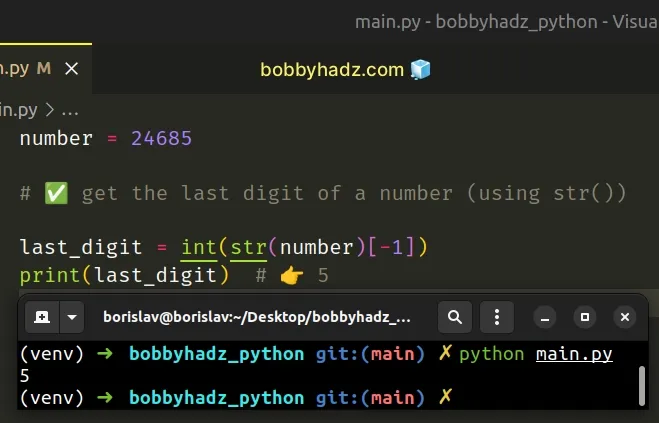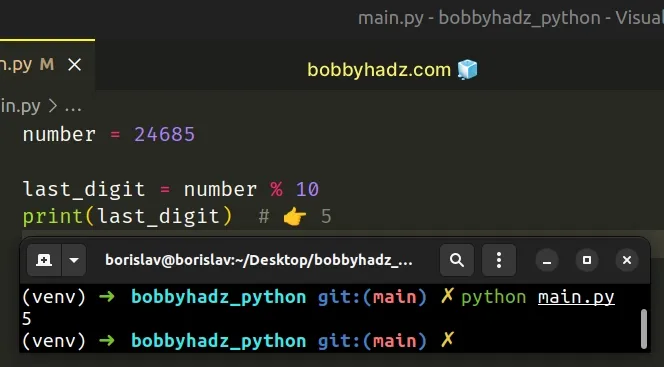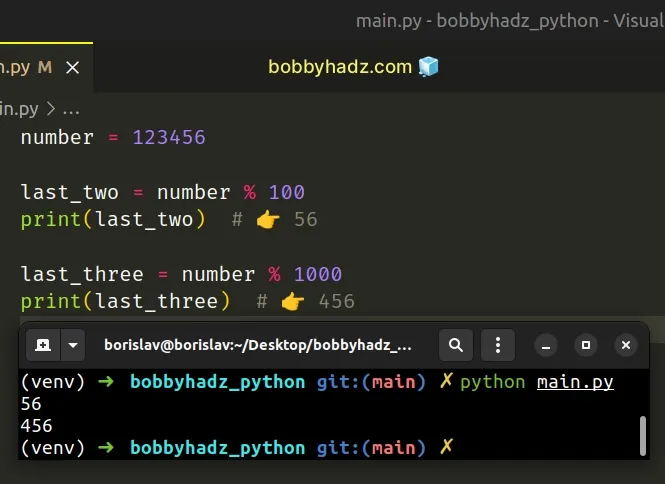Get the last or last N digits of a Number in Python
Last updated: Apr 10, 2024
Reading time·5 min

# Table of Contents
- Get the last digit of a number in Python
- Get the last digit of a number using the modulo operator
- Get the last N digits of a Number in Python
- Get the last N digits of a Number using string slicing
# Get the last digit of a number in Python
To get the last digit of a number:
- Use the
str()class to convert the number to a string. - Access the character at index
-1. - Use the
int()class to convert the result to an integer.
number = 24685 # ✅ Get the last digit of a number (using str()) last_digit = int(str(number)[-1]) print(last_digit) # 👉️ 5

If you need to get the last N digits of a number, click on the following subheading:
We used the str() class to convert the integer to a string so we can access the string at a specific index.
0, and the last character has an index of -1 or len(my_str) - 1.The next step is to access the character at index -1 to get the last digit of
the number.
Once we have the last digit, we can use the int() class to convert the string to an integer.
number = 24685 last_digit = int(str(number)[-1]) print(last_digit) # 👉️ 5
You can use the same approach if you need to get the last N digits of a number.
number = 24685 last_two = int(str(number)[-2:]) print(last_two) # 👉️ 85 last_three = int(str(number)[-3:]) print(last_three) # 👉️ 685
Negative indices can be used to count backward.
# Get the last digit of a number using the modulo operator
Alternatively, you can use the modulo operator.
number = 24685 last_digit = number % 10 print(last_digit) # 👉️ 5

The modulo operator will return the last digit of the number by calculating the remainder of dividing the number by 10.
If the number might be negative, use the abs() function to make sure you get
the correct result.
number = -24685 last_digit = abs(number) % 10 print(last_digit) # 👉️ 5
The abs function returns the absolute value of a number. In other words, if the number is positive, the number is returned, and if the number is negative, the negation of the number is returned.
print(abs(-27)) # 👉️ 27 print(abs(27)) # 👉️ 27
The modulo (%) operator returns the remainder from the division of the first value by the second.
print(10 % 2) # 👉️ 0 print(10 % 4) # 👉️ 2
If the value on the right-hand side is zero, the operator raises a
ZeroDivisionError exception.
We used integers in the example, but the left and right-hand side values may also be floating point numbers.
% operator divides the number by 10 and returns the remainder.For example, the remainder of dividing 12345 by 10 is 5.
number = 12345 print(12345 - 1234 * 10) # 👉️ 5
Here are some more examples.
number = 12345 print(82342 % 10) # 👉️ 2 print(248 % 10) # 👉️ 8 print(150 % 10) # 👉️ 0
# Get the last N digits of a Number in Python
You can also use the modulo operator to get the last N digits of a number.
The modulo operator in the example will return the last 2 digits of the number by calculating the remainder of dividing the number by 100.
number = 123456 last_two = number % 100 print(last_two) # 👉️ 56 last_three = number % 1000 print(last_three) # 👉️ 456

The same approach can be used to get the last 3 digits of a number.
number = 246810 # ✅ Get the last 3 digits of a number last_three = number % 1000 print(last_three) # 👉️ 810
If the number might be negative, use the abs() function to make sure you get
the correct result.
number = -123456 last_two = abs(number) % 100 print(last_two) # 👉️ 56
The abs function returns the absolute value of a number. In other words, if the number is positive, the number is returned, and if the number is negative, the negation of the number is returned.
print(abs(-43)) # 👉️ 43 print(abs(43)) # 👉️ 43
The modulo (%) operator returns the remainder from the division of the first value by the second.
print(10 % 2) # 👉️ 0 print(10 % 4) # 👉️ 2
If the value on the right-hand side is zero, the operator raises a
ZeroDivisionError exception.
We used integers in the example, but the left and right-hand side values may also be floating-point numbers.
% operator divides the number by 100 and returns the remainder.For example, the remainder of dividing 123456 by 100 is 56.
number = 123456 print(123456 - 1234 * 100) # 👉️ 56
Here are some more examples.
# ✅ Get the last 2 digits of a number print(23484 % 100) # 👉️ 84 print(9590 % 100) # 👉️ 90 print(900 % 100) # 👉️ 0
And, here is an example of getting the last three digits of a number.
The remainder of dividing 123456 by 1000 is 456.
print(123456 - 123*1000) # 👉️ 456
Here are some more examples.
# ✅ Get the last 3 digits of a number print(123456 % 1000) # 👉️ 456 print(8523400 % 1000) # 👉️ 400 print(1523000 % 1000) # 👉️ 0
Alternatively, you can use string slicing.
# Get the last N digits of a Number using string slicing
This is a three-step process:
- Use the
str()class to convert the number to a string. - Use string slicing to get the last N characters of the string.
- Use the
int()class to convert the result to an integer.
number = 123456 # ✅ Get the last 2 digits of a number last_two = int(str(number)[-2:]) print(last_two) # 👉️ 56

The same approach can be used to get the last three digits of a number.
number = 246810 # ✅ Get the last 3 digits of a number last_three = int(str(number)[-3:]) print(last_three) # 👉️ 810
We used the str() class to convert the integer to a string so we can use
string slicing.
The syntax for string slicing is my_str[start:stop:step].
The start index is inclusive, whereas the stop index is exclusive (up to,
but not including).
0, and the last character has an index of -1 or len(my_str) - 1.Negative indices can be used to count backward.
The slice my_str[-2:] starts at the second to last character and goes to the
end of the string.
Once we have the last 2 digits, we can use the int() class to convert the
string to an integer.
number = 123456 last_two = int(str(number)[-2:]) print(last_two) # 👉️ 56
Which approach you pick is a matter of personal preference. I'd go with using
the modulo % operator because it's quite intuitive and easy to read.
# Additional Resources
You can learn more about the related topics by checking out the following tutorials:

